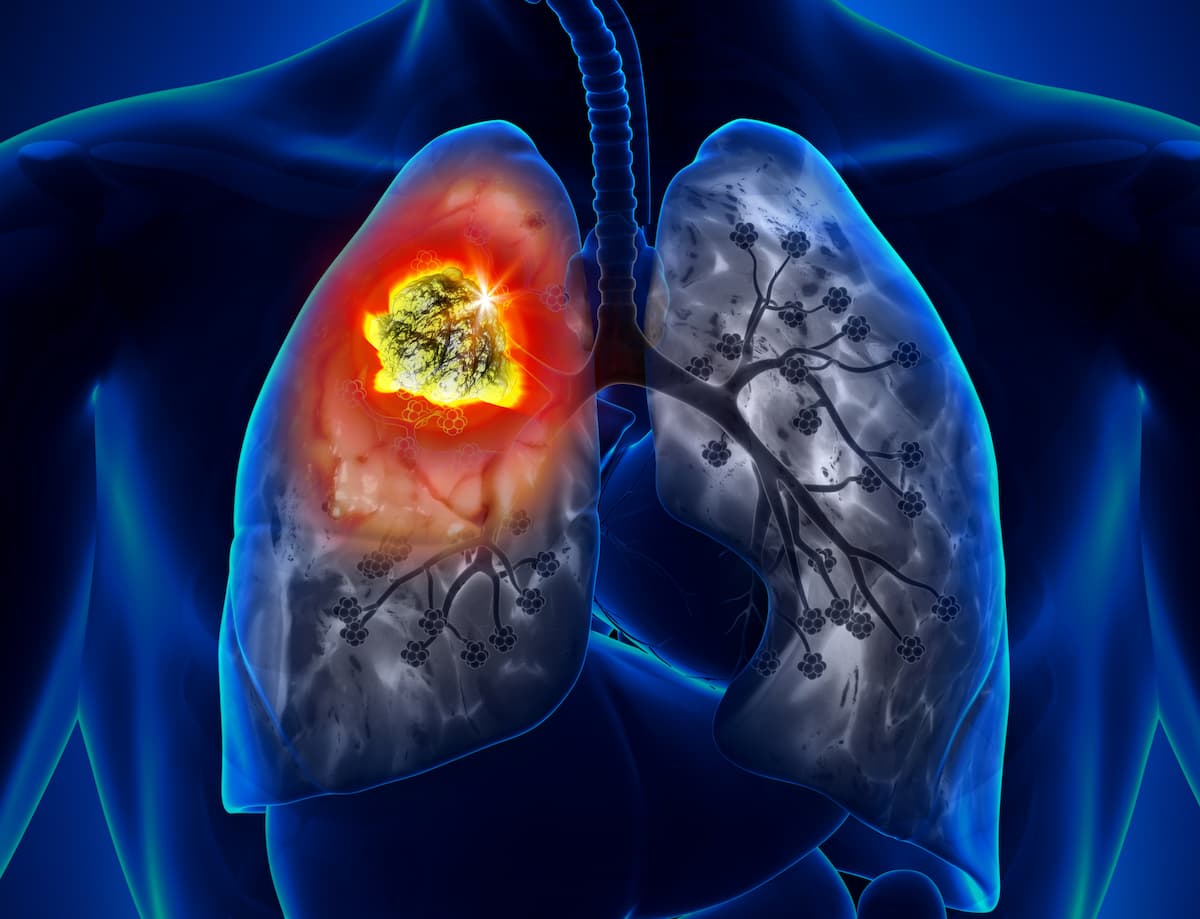
FDA Approves Osimertinib in Advanced EGFR+ NSCLC

Findings from the phase 3 LAURA trial support the approval of osimertinib for advanced EGFR-mutated NSCLC.
The News
The FDA has approved osimertinib (Tagrisso) after concurrent or sequential platinum-based chemoradiation for patients with EGFR exon 19 deletions or exon 21 L858R mutations, locally advanced, unresectable stage III non–small cell lung cancer (NSCLC) as detected by an FDA-approved test, according to according to the FDA.1
The current recommended osimertinib dose is 80 mg once daily with or without food until disease progression or unacceptable toxicity.
Supporting Data
Findings from the
As of the data cut-off date of January 5, 2024, trial results showed an 84% reduction in the risk of progression or death with osimertinib (n = 143) vs placebo (n = 73; HR, 0.16; 95% CI, 0.10-0.24; P < .001). Furthermore, the median progression-free survival (PFS) was 39.1 months (95% CI, 31.5-not calculable) vs 5.6 months (95% CI, 3.7-7.4) for the respective treatment arms. The 12- and 24- month PFS rates were 74% (95% CI, 65%-80%) and 65% (95% CI, 56%-73%) in the investigational arm, respectively, and 22% (95% CI, 13%-32%) and 13% (95% CI, 6%-22%) in the placebo arm.
The objective response rate (ORR) was 57% (95% CI, 49%-66%) in the osimertinib arm vs 33% (95% CI, 22%-45%) in the placebo arm (odds ratio [OR], 2.77; 95% CI, 1.54-5.08). Additionally, a duration of response (DOR) benefit was seen with osimertinib; the median duration was 36.9 months (95% CI, 30.1-not calculable [NC]) vs 6.5 months (95% CI, 3.6-8.3) with placebo. Within each arm, complete responses (CRs), partial responses (PRs), and stable disease were observed in 2%, 55%, and 31% of the osimertinib group and 1%, 32%, and 47% of the placebo group, respectively.
Notably, a greater PFS benefit with osimertinib was observed among patients younger than 65 years (HR, 0.16; 95% CI, 0.10-0.26) than for patients 65 years and older (HR, 0.33; 95% CI, 0.19-0.57). Additionally, patients with exon 19 deletions (HR, 0.17; 95% CI, 0.10-0.29) experienced more benefit than patients with L858R mutations (HR, 0.32; 95% CI, 0.19-0.56). Furthermore, a greater benefit was seen among patients with stage IIIB or IIIC disease (HR, 0.21; 95% CI, 0.13-0.33) than those with stage IIIA disease (HR, 0.28; 95% CI, 0.15-0.52).
Expert Perspective
“The LAURA trial is the first to define the role of EGFR-directed therapy in unresectable stage III disease. [Although] the study did not compare osimertinib [with] the current standard-of-care immunotherapy, these data have major implications for both patients and oncologists and will change the standard of care for patients with EGFR mutations,” said David R. Spigel, MD in a news release on the study findings.4
David R. Spigel, MD, is the chief scientific officer of Sarah Cannon Research Institute in Nashville, Tennessee.
Phase 3 LAURA Trial Design
The trial’s primary end point was PFS per blinded independent central review (BICR). Key secondary end points included OS, central nervous system (CNS) PFS per BICR, ORR, DOR, and safety. Eligible patients were adults diagnosed with EGFR-mutated NSCLC following concurrent or sequential platinum chemoradiotherapy.
Patients were randomly assigned 2:1 to receive either oral osimertinib at a recommended dose of 80 mg once daily or placebo from August 2018 to July 2022. Treatment was continued until disease progression assessed by BICR or fulfillment of other discontinuation criteria. Open-label osimertinib was offered for both patient groups following disease progression.
Patient characteristics were generally balanced in both groups, except for a higher portion of patients with a World Health Organization performance status of 0 in the osimertinib group (56%) compared with the placebo group (42%).
For the investigational and control arms, most patients were female (63%, 58%), never smoked (71%, 67%), and were primarily Asian (81%, 85%). Additionally, the median age was 62 years (range, 36-84) and 64 years (range, 37-83), respectively, and most patients had undergone concurrent chemoradiotherapy prior to treatment (92%, 85%). Additionally, most patients had adenocarcinoma (97%, 95%) and had either a partial response (47%, 37%) or stable disease (43%, 51%) as the best overall response to chemoradiotherapy.
Adverse Events
Between the investigational and control arms, any-grade adverse events (AEs) occurred in 98% and 88% of patients, respectively. Grade 3 or higher AE incidence was 35% in the osimertinib group and 12% with placebo. Additionally, serious AEs were observed in 38% and 15% of each respective arm; 2% and 3% of patients experienced fatal AEs.
AEs categorized as interstitial lung disease occurred in 8% and 1% of the osimertinib and placebo groups. Additionally, 48% and 38% of each respective arm had experienced AEs categorized as radiation pneumonitis.
AEs resulting in dose interruptions, reductions, or discontinuations occurred in 56%, 8%, and 13% of the investigational arm and 25%, 1%, and 5% of the placebo arm, respectively. The median duration of treatment was 24.0 months (range, 0.4-62.9) with osimertinib and 8.3 months (range, 0.5-56.6) with placebo.
Osimertinib previously
References
- FDA approves osimertinib for locally advanced, unresectable (stage III) non-small cell lung cancer following chemoradiation therapy. FDA. News release. September 25, 2024. Accessed September 25, 2024. https://tinyurl.com/pjjj3h9v
- Ramalingam SS, Kato T, Dong X, et al. Osimertinib (osi) after definitive chemoradiotherapy (CRT) in patients (pts) with unresectable stage (stg) III epidermal growth factor receptor-mutated (EGFRm) NSCLC: primary results of the phase 3 LAURA study. J Clin Oncol. 2024;42(suppl 17):LBA4. doi:10.1200/JCO.2024.42.17_suppl.LBA4
- Lu S, Kato T, Dong X, et al. Osimertinib after chemoradiotherapy in stage III EGFR-Mutated NSCLC. N Engl J Med. 2024;391(7):585-597. doi:10.1056/NEJMoa2402614.
- Osimertinib poised to change standard of care treatment for patients with locally advanced EGFR-mutated NSCLC. News release. ASCO. June 2, 2024. Accessed September 18, 2024. https://tinyurl.com/ysrbjpks
- Tagrisso granted priority review in the US for patients with unresectable, stage III EGFR-mutated lung cancer. AstraZeneca. June 10, 2024. Accessed June 10, 2024. https://tinyurl.com/krdahhzt
Newsletter
Stay up to date on recent advances in the multidisciplinary approach to cancer.































































































